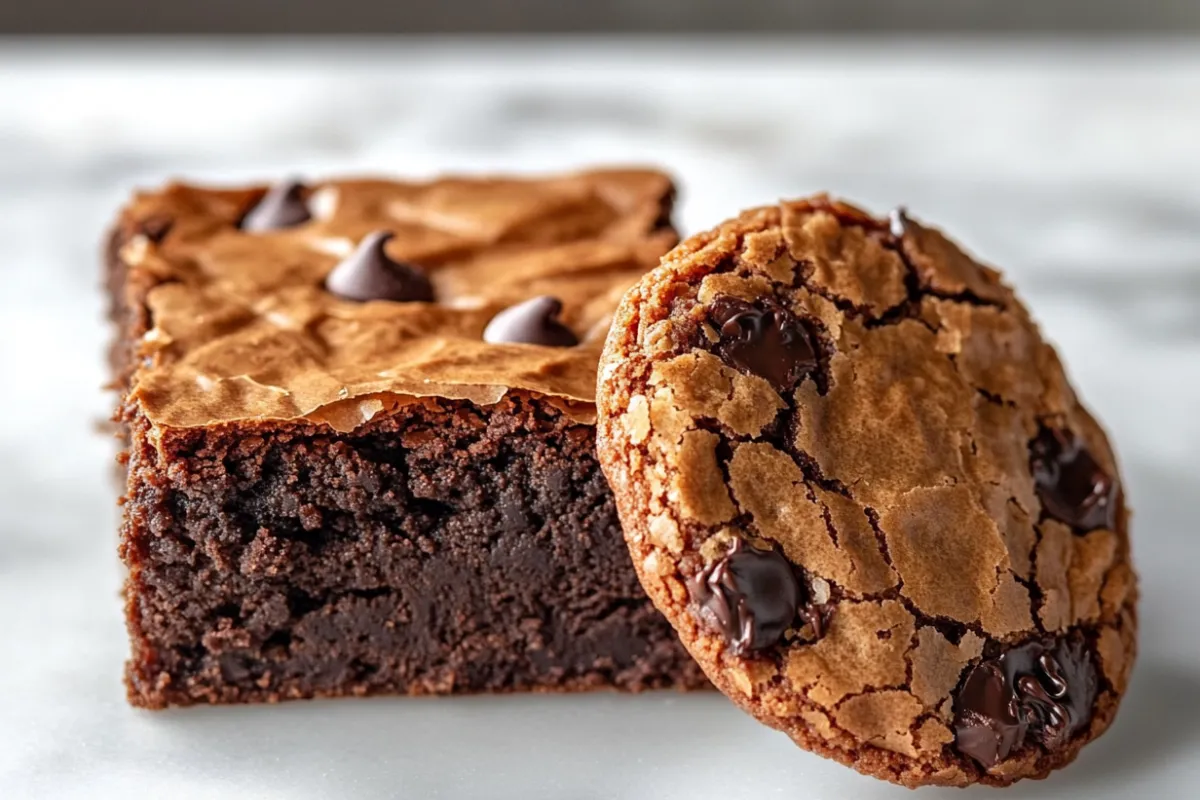Brownies and brownie cookies are two beloved chocolate-based desserts that often cause confusion due to their similarities in flavor. However, while they share ingredients like chocolate, butter, and sugar, their textures, preparation methods, and even flavors differ in several key ways. This article will delve into these differences to help you understand exactly what sets these two treats apart and decide which might be your next favorite dessert to bake.
1. Origins and Basic Differences
Both brownies and brownie cookies share a rich history in American baking, but their primary distinction lies in the intended final product’s texture and preparation method. Brownies were first created as a dense, chocolatey dessert bar, while brownie cookies evolved as a hybrid that combines the richness of brownies with the versatility and ease of cookies.
Similarities:
- Both are chocolate-based.
- Key ingredients include butter, sugar, flour, and chocolate.
Key Differences:
- Brownies are dense, often fudgy or cakey and are usually served as bars.
- Brownie Cookies have a crisp edge with a chewy center, served as individual cookies.
For an excellent brownie or brownie cookie recipe, explore further recipes on this site, where you’ll find great tips for perfecting either dessert.
2. Ingredients Comparison
Both desserts share similar foundational ingredients, but the ingredient ratios and additional items such as leavening agents distinguish one from the other.
Brownie Ingredients:
- Butter or oil
- Cocoa powder or melted chocolate
- Sugar
- Eggs
- Flour
- Vanilla extract (optional)
Brownie Cookie Ingredients:
- Similar base ingredients as brownies
- Baking soda or baking powder for leavening
- Additional flour to achieve a firmer dough for shaping into cookies
The inclusion of leavening agents like baking soda in brownie cookies is crucial because it allows them to rise slightly, resulting in the distinct crisp exterior with a chewy middle, which is a hallmark of a well-made cookie.
3. Texture Differences Between Brownies and Brownie Cookies
The texture of brownies and brownie cookies is one of their most significant distinctions, and it’s what often draws people to prefer one over the other.
Brownies:
- Fudgy brownies are dense and have a melt-in-your-mouth quality due to a higher fat content and lower flour ratio.
- Cakey brownies are lighter, with a more spongy crumb. This texture comes from using more eggs and sometimes incorporating a small amount of baking powder.
Brownie Cookies:
- These have a balance between chewiness and crispness. The edges are typically crisp, while the center remains soft and slightly chewy.
- Consistency is key in brownie cookies. Each cookie delivers a similar texture, unlike brownies, where the edges and center can offer different experiences.
If you’re looking to perfect the chewy consistency of your brownie cookies, check out more tips and recipe variations on this page.
4. Flavor Profiles
While both desserts are known for their chocolate-forward flavors, the way those flavors are experienced can be quite different based on their textures and ingredient ratios.
Brownies:
- The chocolate flavor in brownies, especially fudgy ones, tends to be more intense. The rich, concentrated chocolate taste is the result of using either melted chocolate or cocoa powder as the base.
- Bakers often enhance the flavor with additional ingredients like espresso powder or a touch of vanilla, creating layers of complexity.
Brownie Cookies:
- In brownie cookies, the flavor is still chocolatey but often more balanced due to the added flour and leavening agents. This can result in a slightly less intense chocolate flavor compared to brownies.
- Despite the mellowed chocolate profile, brownie cookies can be just as flavorful, especially if made with high-quality cocoa powder or melted chocolate chunks.
5. Baking Techniques
The preparation and baking techniques for brownies and brownie cookies are surprisingly different, even though they share a lot of the same ingredients.
Brownies:
- Baking Time: Brownies are typically poured into a single pan and baked at once. Depending on whether you prefer fudgy or cakey brownies, they bake for 25 to 40 minutes.
- Preparation: Brownies are simpler to prepare, involving fewer steps. You mix the batter, pour it into the pan, and bake.
Brownie Cookies:
- Baking Time: Brownie cookies bake for a shorter time (about 10-12 minutes), but the dough often requires chilling before baking to achieve the right texture.
- Preparation: These cookies require a more involved process, such as mixing, shaping, and sometimes chilling dough between batches, but the result is worth the effort.
Chilling the dough helps the cookies maintain their shape and avoid spreading too much during baking. This technique is particularly important for ensuring the chewy texture in the center.
6. Customization and Flavor Variations
One of the most enjoyable aspects of both brownies and brownie cookies is the ability to customize them according to your personal taste.
Brownies:
- Add-ins like chocolate chips, nuts, or caramel swirls can introduce exciting textures to brownies.
- Toppings such as powdered sugar or drizzled chocolate can elevate their appearance and taste.
Brownie Cookies:
- Brownie cookies can also be enhanced with chocolate chunks, nuts, or even a touch of espresso powder for a richer flavor.
- Some bakers love adding a sprinkle of sea salt on top to contrast the sweetness and enhance the chocolate’s depth.
7. Serving Suggestions
Presentation and serving suggestions vary depending on whether you’re serving brownies or brownie cookies, and each can be tailored to suit different occasions.
Brownies:
- Traditionally, brownies are cut into squares or rectangles and served as bars.
- They can be enjoyed warm, cold, or at room temperature, depending on your preference.
Brownie Cookies:
- Brownie cookies are perfect for casual gatherings, often presented stacked on a plate or arranged in neat rows for a more formal presentation.
- For an elegant touch, you can dip half of each cookie in melted chocolate or decorate them with a drizzle of white chocolate.
8. Advanced Baking Tips
If you’re looking to take your brownie or brownie cookie game to the next level, here are a few advanced tips and tricks to consider:
- Double the Chocolate: Adding chocolate chunks or chips into your brownie or cookie batter creates pockets of melted chocolate that enhance the overall experience.
- Brown Butter Boost: Using browned butter in your recipe adds a rich, nutty flavor that elevates both brownies and brownie cookies.
- Create a Marbled Effect: For brownies, swirling in cream cheese or peanut butter creates a beautiful marbled effect and adds a delightful contrast in flavor.
These variations not only add visual appeal but also introduce new layers of flavor to your dessert.
Conclusion
Though brownies and brownie cookies share many similarities, they each offer a unique experience in terms of texture, flavor, and preparation. Whether you prefer the dense, fudgy decadence of brownies or the crisp, chewy texture of brownie cookies, both desserts provide endless possibilities for customization and enjoyment.
By understanding the key differences between these two treats, you can now confidently decide which one suits your next baking adventure. Whether you’re a brownie lover or a cookie fanatic, there’s no wrong choice—both desserts will satisfy your chocolate cravings in the best possible way.
Be sure to check out more baking tips and recipes for a deeper dive into the world of brownies, cookies, and everything in between!

